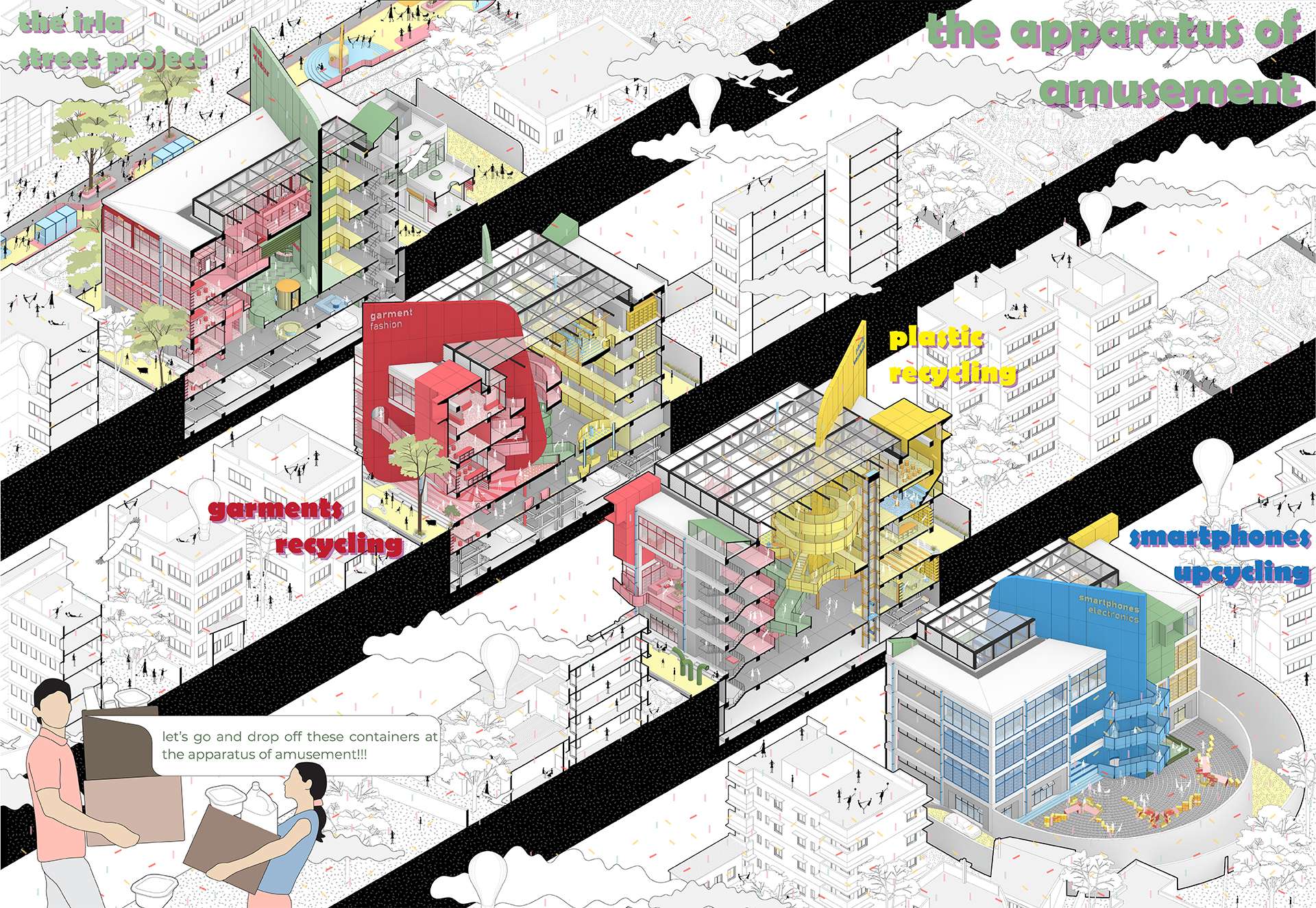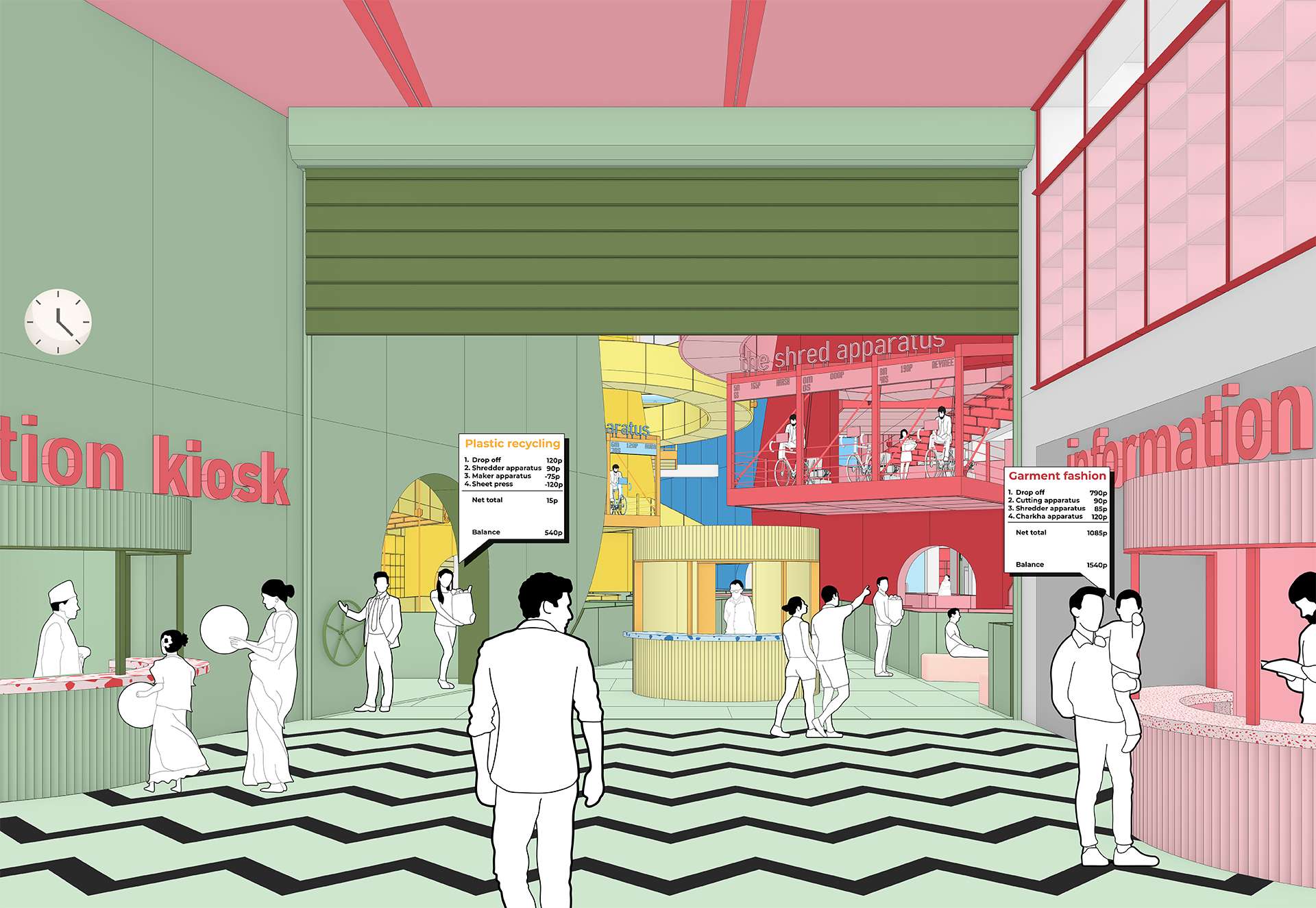"Apparatus of amusement" stems from the will to understand the age of Anthropocene and the impact of our species on our surroundings ecosystem largely as a result of the commodified world we have built and inhabit. The project traces the roots which have led to our contemporary capitalist modus operandi, the motifs which have driven it and the consumerist strategies which have lead us to a numb state of mindless consumption and summarises this consumerist typology with the typology of the ‘shopping mall’ and the collective notion of excesses termed as ‘waste’.
With this in mind, the study tries to map the end of life journey of an everyday object in an urban setting of Mumbai by undertaking a study on the formal excess network of Mumbai, the role of the informal agents and the existing network of repurpose. The project thus asks us to consider a point in transition from post-consumption to trash, and offers an alternate repurpose solution for these objects and a proposed network of these post-consumption processes which informs the shortcomings of our primary system of waste management and the exceeded landfills.
The project attempts to reverse the conventional notion of retail in the hyper-mediated urban setting of Prime Mall in Mumbai by seductively engaging the consumers with the repurpose of these post-consumption objects from the assembly line to the final product reframing our role in our contemporary social and ecological environments.
The project was developed at the Rachana Sansad’s Academy of Architecture.

KOOZ What prompted the project?
AG The project stems from the will of better understanding the age of Anthropocene through the lens of our consumerist society. To this end I was particularly engaged with the works of Jean Baudrillard, Guy Debord and Margaret Crawford and the critical enquiries raised by them towards understanding the consumerist cultural milieu.
KOOZ What questions does the project raise and which does it address?
AG The project tries to reframe the way we consume and treat the excess waste generated. Firstly, it points out the loops in the cycle, then addresses them with decentralised systems. This is injected at the epitome of the consumerist culture, which is a shopping mall. The project proposes to be a circular process in itself, hence reducing the amount of waste sent to landfills.
KOOZ How does the project challenge and re-define the role of the mall in our society?
AG Malls are considered as a simulated form of a city center. They are meant to be consumed in a syntax which induces passivity in consumers. The shift in paradigm has to be towards making it a place to repurpose what is consumed and hence closing the loop by proposing a second life cycle to discarded objects.
KOOZ How and to what extent has this typology exacerbated the consumerism in our society?
AG The idea of creating a world within an the boundaries of envelope of a mall, where a person can consume endlessly. The mindless consumption sedating the consumers drives the space and induces passivity in them. What lies post consumption is kept away from the consumers and is considered as someone else’s job.
KOOZ What role can architecture play in reverting this trend?
AG Architecture should be approached beyond the idea of space, making the process cross-disciplinary. We can collaborate with various stakeholders in devising systems which gets the consumed objects back in the primary cycle. The larger role of corporations have to be reformed which can be accommodated through architecture.
KOOZ Within the era of the Anthropocene, how does the project approach the role of the architect?
AG The projects works on two levels where the mall is repurposed by retaining the structural system and also by reclaiming materials from the existing dysfunctional mall. The additions are made which are required programmatically, which changes the approach from a brownfield project. At a programmatic level, the apparatuses are devices which interacts with the consumers, actively helping in repurposing self-consumed objects on a incentive based system. The approach always questioned the function and purpose of the existing typologies and systems and where we push them ahead and reimagine the way they work.
KOOZ What is for you the power of the architectural imaginary?
AG The architectural discourse isn’t restricted to the physical built form, it is inspired by various disciplines as well. So, for the project the precedent study to the architectural response had a strong influence from the Wall House by John Hejduk. This became the anchor of the Wall of Labour as the programmatic injectors. The architectural imaginary should always root from a precedent study and further pushing the boundaries for an added project driven response.

Bio
Aum Gohil is a recent graduate in Architecture from Rachana Sansad’s Academy of Architecture, Mumbai. Aum is currently working as an architect at Sameep Padora and associates (sP+a) in Mumbai.





